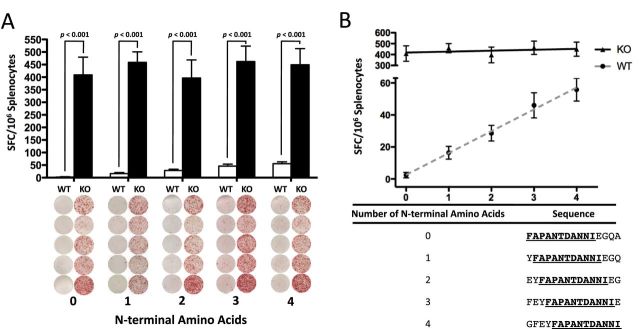Fig. 2.

ERAP1 ablates response to ERAP1−/− IDTAP linearly with the number of N-terminal residues prior to a consensus sequence. C56BL/6 mice (n = 5) or ERAP1−/− mice (n = 5) were immunized I.M. in the tibialis anterior with Ad5-C. difficile-TA as described in Methods. At day 14, mice were sacrificed and splenocytes were harvested and stimulated with 2 μg per well of the listed 15-mer peptides. Five peptides were generated that contained the consensus sequence FAPANTDANNI and 0, 1, 2, 3 or 4 additional N-terminal residues. These peptides were used to stimulate splenocytes using an ELISpot technique. As expected each peptide generated a strong response in ERAP1−/− mice, and very low responses in corresponding WT animals (A). A linear regression was performed (dotted gray line) to examine if N-terminal extension of the consensus sequence would provide incremental protection from ERAP1-mediated destruction (B). The number of specific spots per 106 splenocytes stimulated were graphed on the y-axis and the number of N-terminal amino acids before the consensus sequence were plotted on the x-axis. In WT cells, for each additional N-terminal amino acid in front of the consensus sequence, 13.67 (± 1.892) additional spots per 106 were observed to respond. There was no strong relationship observed in ERAP1−/− cells. R 2 of 0.9948 for WT and 0.1903 for ERAP1−/−. Error is shown above and below each point. The figure is representative of two separate experiments.
